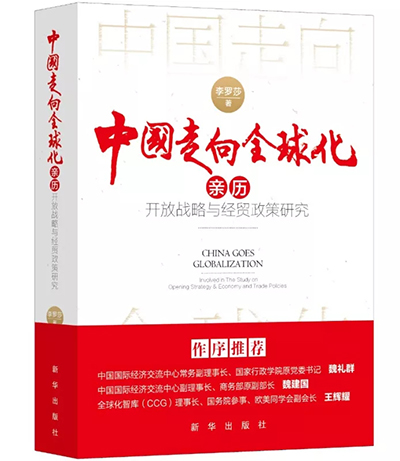全球化(globalization)一词,是一种概念,也是一种人类社会发展的现象过程。全球化目前有诸多定义,通常意义上的全球化是指全球联系不断增强,人类生活在全球规模的基础上发展及全球意识的崛起。国与国之间在政治、经济贸易上互相依存。全球化亦可以解释为世界的压缩和视全球为一个整体。二十世纪九十年代后,随着全球化势力对人类社会影响层面的扩张,已逐渐引起各国政治、教育、社会及文化等学科领域的重视,引发大规模的研究热潮。对于“全球化”的观感是好是坏,目前仍是见仁见智,例如全球化对于本土文化来说就是一把双刃剑,它也会使得本土文化的内涵与自我更新能力逐渐模糊与丧失。
- CCG南方国际人才研究院
- CCG北方国际人才研究院
- CCG一带一路研究所
- CCG世界华商研究所
- CCG数字经济委员会
- CCG南方国际人才研究院图片
- CCG北方国际人才研究院图片
- CCG世界华商研究所图片
- CCG一带一路研究所图片
- CCG数字经济委员会图片
- 成为系列论坛会员
- 成为系列论坛会员联系
- 概况介绍
- 兼职研究员
- 未分类
- 概况
- 全球化
- 全球治理
- 美国
- 国际人才政策
- 中美贸易
- 国际教育理念与政策
- 中国开放指数
- 新闻动态
- CCG品牌论坛
- 中国与全球化论坛
- 学术委员会专家
- 主席/理事长
- 中文图书
- 品牌论坛
- 研究合作
- 重点支持智库研究与活动项目
- 概况视频
- 主任
- 香港委员会名誉主席
- 关于
- 团队
- 国际关系
- 国际组织
- 加拿大
- 华人华侨
- 国际贸易
- 来华留学
- 区域与城市
- 媒体报道
- 二轨外交
- 中国企业全球化论坛
- 高级研究员
- 资深副主席
- 英文图书
- 圆桌研讨
- 建言献策
- 概况手册
- 副主任
- 理事申请
- 香港委员会名誉副主席
- 顾问
- 研究
- 国际移民与人才流动
- 区域合作
- 欧洲
- 中国海归
- 来华投资
- 出国留学
- 大湾区
- 活动预告
- 名家演讲
- 中国全球智库创新年会
- 特邀高级研究员
- 副主席
- 杂志
- 名家演讲
- 媒体采访
- 年报
- 秘书长
- 企业理事
- 香港委员会主席
- 国际顾问
- 国际贸易与投资
- 一带一路
- 亚洲
- 留学生
- 对外投资
- 国际学校
- 动态
- 名家午餐会
- 中国人才50人论坛
- 特邀研究员
- 理事长
- 媒体采访
- 文章投稿
- 副秘书长
- 活动支持
- 香港委员会副主席
- 国际教育
- 非洲
- 数字贸易
- 活动
- 智库圆桌会
- 常务理事
- 智库访谈
- 国际合作
- 总监
- 中国留学人员创新创业论坛
- 研究员
- 研究支持
- 香港委员会常务理事
- 国内政策
- 拉美
- 专家
- 理事
- 直播
- 捐赠支持
- 主管
- 中国国际教育论坛
- 个人捐赠
- 前瞻研究
- 澳洲
- 咨询委员会
- 企业理事
- 其他
- 捐赠联系
- 中东
- 成为理事
- 研究报告
- 建言献策
- 出版物
- 理事申请联系
- 智库研究
- 音视频专区
- 联系我们
- 观点
- 捐赠
- 工作机会
- 香港委员会
-

He Weiwen: China-US trade growth over the past augurs Coop. to continue
By He Weiwen, a senior research fellow at the Center for China and Globalization(CCG). The China-US two-way trade has witnessed the most gigantic growth in human history over the past 40 years since diplomatic relations was established in 1979, but also the largest trade friction in the history of world trade in 2018. The China-US two-way trade volume increased by 238-fold in the past 39 years, from 2.45 billion U.S. dollars in 1979 to 583.70 billion U.S. dollars in 2017. The first 11 months of 2018 saw trade volume reach 582.87 billion U.S. dollars, with the whole year volume set to create a new historic high, despite the massive trade frictions imposed by the Trump Administration. Trade and investment relations between the two countries can be roughly divided into four periods over the past 40 years. A Chinese Ministry of Commerce regular press conference, December 13, 2018. /VCG Photo. Period One, 1979-1988. The first decade of diplomatic ties saw a sound business relationship with no major issues. Trade volume increased from 2.45 billion U.S. dollars in 1979 to 12.3 billion U.S. dollars in 1989, representing a 5-fold increase in 10 years. Large numbers of U.S. multinational enterprises started making investments or having a presence in China, including Boeing, Coca-Cola, Weyerhaeuser, IBM, etc. Period Two, 1989-1999. It was a difficult decade. Bilateral trade relations deteriorated drastically after 1989. The U.S. intensified restrictions on high-tech exports to China, resulting in a fall of trade in 1990. During the 1990s, China and the U.S. have three rounds of negotiations: the U.S. 301, super 301 and 307 investigations. Both sides finally reached agreements in each of them. In 1999, the NATO bombing of the Chinese Embassy to Yugoslavia caused a crisis in bilateral diplomatic relations. Nonetheless, all the turbulence or difficulties did not stop the fast trade growth. China-U.S. trade reached 61.48 billion U.S. dollars in 1999. What is more important, both governments reached the historic agreement on China’s accession to WTO, a decisive step towards China’s WTO membership. Period Three, 2000-2016. Bilateral trade gained further momentum. Although bilateral diplomatic relations again fell into a new critical difficulty due to an incident involving a U.S. spy airplane that killed a Chinese pilot over the South China Sea in early 2001. The 9/11 incident in the U.S. brought bilateral relations back on track and China became a full member of WTO on December 11, 2001. China’s WTO accession was a strong force behind bilateral business relations. The two-way trade volume hit 519.6 billion U.S. dollars, an increase of 597.7 percent over 2000, or 12 percent per annum. China’s direct investment in the U.S. started to soar in 2014 and culminated in 45.6 billion U.S. dollars in 2016. Period Four, 2017-2018. The Trump Administration set China as the largest target of the trade war and launched a 301 investigation which resulted in 10-25 percent additional tariffs on $250 billion of Chinese exports to the U.S., never seen in the bilateral trade relations over the past 39 years, nor in the history of world trade. Despite that, the two-way trade has been growing astonishingly well. It reached 583.7 billion U.S. dollars in 2017, an all-time high, rising 12.3 percent over the previous year, and 582.8 billion U.S. dollars in the first 11 months of 2018, 12.9 percent up year-on-year. A new historic high is set to happen this year. Due to the Trump Administration’s strict restrictions, China’s investment in the U.S. saw a 40-percent decline in 2016 and a further 90-percent fall in the first half of 2018. On the other hand, the U.S. investment in China has kept a marginal rise. The fundamental reasons behind current China-U.S. trade frictions are: First, the U.S. does not tolerant China’s rise as a socialist power under the leadership of CPC. Second, the U.S. tries its best to stop China from threatening the U.S.’s world dominance in high tech and high-end manufacturing. Traders work on the floor of the New York Stock Exchange (NYSE) on December 7, 2018 in New York City. /VCG Photo. And thirdly, the U.S. does not accept China’s Belt and Road Initiative in reshaping the world order. As a result, bilateral trade tensions will continue, although it is almost certain that the current 90-day bilateral trade negotiation will reach an agreement. On the other hand, it is less likely that the relationship between the two countries will “derail” and enter a new cold war. The fundamentals lie in the fact that both economies have been intertwined into the global supply chain and thus could not be derailed by any policies. In 2015 alone, bilateral trade and investment supported 2.6 million jobs and contributed 1.2 percentage points GDP growth in the U.S.. By the end of 2017, the total U.S. investment stock in China hit over 200 billion U.S. dollars with sales in China’s market exceeding 600 billion U.S. dollars and total profit exceeding 70 billion U.S. dollars. GM had a global sale of 8.9 million units in 2017, with 4.04 million units, or 45.4 percent sold in China. China’s market shares in the top 10 U.S. semiconductor companies in 2017 ranged from 80 percent for Skyworks Solutions, 63 percent for Qualcomm, 52 percent for Broadcom, 50 percent for Micron, to 23 percent for Intel. As a result, no political force can change these economics. Looking ahead, China and US trade relations, whatever the twists and turns, will ultimately return to the track of win-win cooperation and stable growth, benefiting the two nations and contributing to the world’s economic growth as well. From CNTN, December 18, 2017
2018年12月25日 -

《中国走向全球化——亲历开放战略与经贸政策研究》发布
2018年12月19日,全球化智库(CCG)和新华出版社联合发布了CCG高级研究员、商务部前副司长、中国国际经济交流中心前研究员李罗莎的最新著作《中国走向全球化--亲历开放战略与经贸政策研究》。该图书收录了李罗莎女士亲历改革开放四十年间,参与研究或独立研究与中国对外开放问题相关的文章,通过解读中国改革开放四十年来的经贸发展,深入分析、聚焦破解难点问题,围绕中国如何在未来提高对外开放水平提出了相关战略和政策建议。
2018年12月24日 -

魏建国:西班牙将引领中欧“一带一路”第三方市场合作
专家简介
2018年12月18日 -

何伟文:中美经贸关系规律任何政治人物都无法颠覆
专家简介
2018年12月18日 -

庞中英:中国企业面对“全球化悖论”寒冬如何避免被冻死?
庞中英,CCG特邀高级研究员,中国海洋大学海洋发展研究院院长
2018年12月13日


